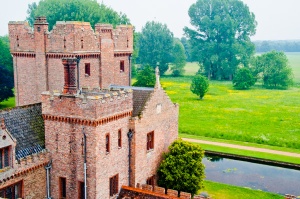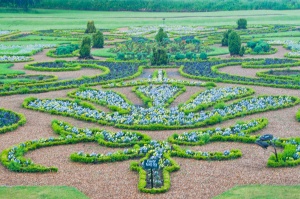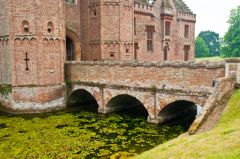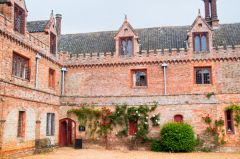
Oxburgh Hall is a late 15th-century moated manor house built by Sir Edmund Bedingfield. Sir Edmund received a license to crenellate in 1482, but it seems likely that work on the Hall was underway before that time, for the license gives him a pardon for any work already undertaken.
By the late 15th century strong defensive measures were no longer necessary, and Oxburgh Hall pays no more than a passing heed to military might. The house - and it is very much a house rather than a fortification - consists of four domestic ranges around a courtyard, all contained within a wide moat.
On the north side is the only real defensive part of the Hall; a tall gatehouse flanked by a pair of striking polygonal towers. Cross-slits in the walls provide covering fire for the gateway passage, which is overhung by machicolations.
The upper levels of the seven-stage gatehouse towers are reached by a spiral stair unusually built of brick. Even the handrail of the staircase is made of brick. Oxburgh Hall was one of the last fortified houses that would have afforded the residents any real measure of defence again attack, but for the most part, it was built for show.
Though most of the east, west, and north wings are original 15th-century work, the south wing was rebuilt in 1865 with the help of architect AW Pugin, who is best remembered for his work on the Palace of Westminster.

History of Oxburgh Hall
The village of Oxburgh is recorded in the Domesday Book as Oxenburgh - a fortified place where oxen are kept. Before the fenland was drained the area was marshland, with only pockets of higher ground. An area like this would have been ideal for defensive purposes.
In 1274 the estate was owned by Thomas de Wayland, Chief Justiciar to Edward I. Wayland was convicted of embezzlement from the crown and forced to flee into exile.
His fate was mild compared to that of a later owner, Sir Thomas Tuddenham, who was executed for treason in 1462. The estate passed to Sir Thomas's sister, who had married Sir Edmund Bedingfield.
Bedingfield supported the Yorkist side in the Wars of the Roses, but he must have been a cautious man, or he saw which way the political winds were blowing, for he was conspicuous by his absence from Richard III's forces at the Battle of Bosworth.
He did appear at the Battle of Stoke in 1487 to support the new king, Henry VII. As a result, Sir Edmund and his Bedingfield descendants enjoyed royal favour over the ensuing century. A Bedingfield was set to guard Catherine of Aragon, and later, to watch over the future Elizabeth I.

The Priest's Hole
The Bedingfields of Oxburgh were traditionally Catholics, and like many Catholic nobiles they had a priest either resident or visiting to celebrate Mass. In the post-Reformation era, it was illegal to practise Catholicism, but this did not stop the Bedingfields from following their faith.
In 1589 they built a secret chamber, a priest's hole, where a priest could hide if the Hall was raided by the authorities. A system of secret signals was devised; the sign that a service was being held was when the washing was left out.
The tiny secret chamber is reached through a small trapdoor in the floor. The top surface of the trapdoor blends in with the tiled flooring so that it appears invisible when shut. Agile visitors can climb down into the chamber - it's more awkward than it looks!
The Bedingfields suffered for their adherence to Catholicism; they were regularly fined and denied careers in the military and in politics. As a result, the family fortunes declined and Oxburgh hall began to fall into disrepair.
Things got worse in the 17th century when the Bedingfields supported the Royalist cause. Sir Henry Bedingfield was imprisoned in the Tower of London, one son was wounded, and another forced to flee abroad. Parliamentary troops ransacked the Hall and destroyed the gardens.
After the Restoration of the monarchy, the Bedingfields might have expected some form of reward or compensation from Charles II, but none was forthcoming. Sir Henry's bitterness is obvious in the Library, where a row of dummy books is entitled 'Rewards to Sir Henry Bedingfield, His Loyaltie'.

The house was partially restored in the Victorian period, and many of the interior furnishings are from that period. But disaster was narrowly averted after the Second World war when the 9th Baronet sold the house to a local timber merchant who planned to tear it down and harvest trees on the estate.
Lady Sybil Bedingfield sold off much of the interior contents and persuaded other family members to sell their own houses. Together they raised enough money to buy the property back and save it from destruction. In 1952 the family granted Oxburgh to the National Trust, but they continue to live in the Hall.
Highlights of the interior include the King's Room, where Henry VII stayed in 1487 while visiting with his queen, Elizabeth of York. The room is dominated by a huge four-poster bed with beautifully carved corner posts.
Oxburgh boasts needlework hangings created by Mary, Queen of Scots while she was held in custody by the Earl of Shrewsbury. There are more wall hangings by a woman who was only marginally less famous in her day, Bess of Hardwick, wife of the Earl.
One unsubstantiated story suggests that Oxburgh hall is haunted by the spectre of a 16th-century Spanish woman who disappeared under mysterious circumstances.
Visiting Oxburgh
It is hard to imagine a more romantic medieval house than Oxburgh (other candidates might include Broughton Castle, Oxfordshire, and another National Trust manor at Ightham Mote, Kent). The beautiful gatehouse towers over a peaceful moat, and looks over a small formal garden area to the east, and a shady walk leads along the canal that feeds the moat.
To the north-west of the Hall is a wooded area where a small Victorian family chapel stands, built with recycled materials in 1830. To the north is the medieval parish church of St John. The church is a gem; well worth visiting to see the Bedingfield Chapel, built by the wife of the Sir Edmund Bedingfield who erected the Hall.
The late 15th and early 16th century Bedingfield tombs are built of terracotta and have been called the finest such tombs in England. The combination of the moated house, gardens, and church make Oxburgh a delight to visit. I highly recommend it.
About Oxburgh Hall
Address: Oxborough,
near Swaffham,
Norfolk,
England, PE33 9PS
Attraction Type: Historic House
Location: 7 m SW Swaffham
Website: Oxburgh Hall
Email: oxburghhall@nationaltrust.org.uk
National Trust - see also:
National Trust memberships (official website link)
Location
map
OS: TF742 012
Photo Credit: David Ross and Britain Express
HERITAGE
 We've 'tagged' this attraction information to help you find related historic attractions and learn more about major time periods mentioned.
We've 'tagged' this attraction information to help you find related historic attractions and learn more about major time periods mentioned.
Historic Time Periods:
Find other attractions tagged with:
15th century (Time Period) - 16th century (Time Period) - 17th century (Time Period) - AW Pugin (Person) - Battle of Bosworth (Historical Reference) - castle (Architecture) - Charles II (Person) - Domesday Book (Historical Reference) - Edward I (Person) - Elizabeth I (Person) - Henry VII (Person) - Mary, Queen of Scots (Person) - Medieval (Time Period) - moat (Historical Reference) - Parliamentary (Historical Reference) - Queen Elizabeth (Person) - Reformation (Historical Reference) - Restoration (Historical Reference) - Richard III (Person) - Royalist (Person) - Tudor (Time Period) - Victorian (Time Period) - Wars of the Roses (Historical Reference) -
NEARBY HISTORIC ATTRACTIONS
Heritage Rated from 1- 5 (low to exceptional) on historic interest
Oxborough, St John's Church - 0.2 miles (Historic Church) ![]()
Gooderstone, St George's Church - 1.6 miles (Historic Church) ![]()
Northwold, St Andrew's Church - 2.4 miles (Historic Church) ![]()
Beachamwell, St Mary's Church - 2.8 miles (Historic Church) ![]()
Barton Bendish, St Mary's Church - 3.3 miles (Historic Church) ![]()
Feltwell, St Nicholas Church - 6.6 miles (Historic Church) ![]()
Weeting Castle - 7.9 miles (Castle) ![]()
Hockwold, St Peter's Church - 8.2 miles (Historic Church) ![]()














